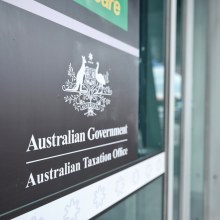Compliance crackdown to claw back $9.1b in tax
Treasury aims to claw back $9.1 billion in unpaid tax over the next five years by cracking down on compliance with the GST, personal income tax and financial crime.
The tax office will receive $588 million in funding for increased GST compliance, which is estimated to rake in $788 million in revenue next financial year alone, and $3.8 billion for the four financial years from July 1, 2023.

The ATO will help target tax avoiders as part of a compliance crackdown. Luis Enrique Ascui
The compliance measures are in addition to a broader push by the Albanese government to improve revenue by $13.7 billion via measures including a minimum 15 per cent tax on multinationals and tightening taxes on LNG producers.
The tax office will also ramp up the scope of investigations into “emerging areas of risk” such as deductions to personal income tax related to letting short-term rentals that were not genuinely available to rent.
The government also planned to improve engagement with taxpayers which would, according to the budget papers, “ensure timely payment of tax”.
Treasury predicted that this, alongside efforts to improve awareness of employers’ superannuation liabilities, would raise more than $442 million in the next four financial years.
But the budget papers warn that federal government would lose around $4.4 billion of that $9.1 billion in revenue, however. Around $3.4 billion would go to the states and territories as they gleaned their share of the recovered GST payments, while the remainder would go to funding the compliance programs.
According to the Treasury papers, the “measures to enhance tax system compliance and integrity”, alongside all other policies announced in the budget, were focused on making “the tax system fairer and more sustainable”.
ATO to lead crackdown
The tax office, which will be responsible for the brunt of the compliance push, said that shrinking the amount of tax paid in reality compared to what it was owed on paper as a proportion of revenue was a key priority next financial year.
It nominated “reducing the gap to a level as low as practicable given the nature and complexity of the law and the resources available” as one of its key performance measures in a statement in Treasury’s portfolio budget statement.
It also said it aimed to keep the ratio of collectable debt to net tax collections to 8 per cent to 8.5 per cent, but warned it was “at risk” of not meeting this.
The tax office was still ambitious about how it could improve this figure with the increased funding, however, aiming to lower this target to 7.5 per cent to 8 per cent next financial year.
It planned to continue with these reductions until the 2025-26 financial year, after which it would stick with a goal of 6 per cent.
The difference between collectable and uncollectable debt is largely due to businesses going bankrupt with unpaid tax liabilities they cannot service. The debts also include tax that is paid late or incorrectly.
The tax office hoped that the total revenue from all its compliance activities – meaning all its attempts to recover unpaid tax – would hit $15 million this financial year. The Treasury budget statement said it was on track to meet this, and that it aimed to increase that figure to $15.7 billion in 2023-24.
